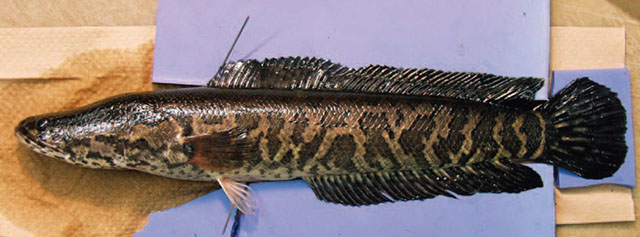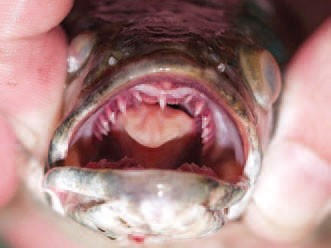Northern snakehead
What you need to know about the northern snakehead. Includes habitat, identifying features and what you can do to reduce its impact.
The northern snakehead is a predatory fish native to southern and eastern Asia that is now found in several American states. The fish was likely introduced to the United States by people who bought live snakehead from fish markets or pet shops and later released them into lakes, rivers or ponds.

The northern snakehead is a voracious predator that lives in lakes, ponds, rivers and streams in water temperatures ranging from 0° to 30°C. It has been reported to travel on land for short distances by wiggling its body forward.
A lung-like organ enables it to absorb oxygen by gulping air at the surface, allowing it to thrive in water that is low in oxygen and to survive out of water in moist conditions for up to four days.

The snakehead has been dubbed a “frankenfish” because of its reptile-like behaviour, aggressive eating habits and mouthful of long, sharp teeth.
Range
Outside its native range, northern snakeheads have established breeding populations in the states of Virginia, Maryland, Pennsylvania and New York. Small numbers of fish have been found in several other states.
Possible impacts of Northern Snakehead in Ontario
The northern snakehead could spread throughout the Great Lakes watershed and seriously threaten native fish and invertebrate populations in Ontario.
- The northern snakehead has no natural enemies in North America. It eats native zooplankton, fish and fish larvae, frogs and toads, invertebrates, insects, small reptiles and even small birds and mammals.
- The northern snakehead’s ability to eat a wide range of foods and live in varied conditions allows it to compete with many native fish for food and habitat.
- Because the northern snakehead is highly adaptable it is likely to thrive in Ontario waters.
To prevent this unwanted invader from coming into Ontario, the province has banned the live possession and sale of all 28 species of snakehead, as well as other invasive fish species.
How to identify Northern Snakehead
The northern snakehead can grow up to 85 centimetres long and weigh as much as seven kilograms. With a narrow, torpedo-shaped body and a long dorsal (back) fin, northern snakehead looks similar to Ontario’s native bowfin (Amia calva), and burbot (Lota lota).
Check the chart below to know if you have a snakehead, a bowfin or another species.
Northern Snakehead (Channa argus)
- Enlarged scales on head
- Single long dorsal fin
- No bony plates on underside of head
- Pelvic fins closer to head compared to bowfin
- Anal fin almost as long as dorsal fin
- No eyespot on caudal peduncle (tail)

Bowfin (Amia calva)
- No scales on head
- Single long dorsal fin
- Bony plate (gular plate) present on underside of head
- Pelvic fins at mid-body
- Short anal fin
- Eyespot on caudal peduncle (tail) of males and juveniles

Burbot (Lota lota)
- Generally no visible scales
- Two dorsal fins, short one followed by a long one
- No bony plate on underside of head
- Pelvic fins in front of pectoral fins
- Long anal fin
- No eyespot on caudal peduncle (tail)
- Single barbel on chin

What can I do?
- Learn how to identify northern snakehead and how to prevent the introduction of this unwanted species.
- Never buy or keep live snakehead. It is against the law to keep a snakehead as a pet or have a live snakehead in your possession.
- Don’t release any live fish into Ontario lakes, rivers or streams. Return or donate unwanted aquarium fish to a pet store or local school.
- If you have any information about the illegal importation, distribution or sale of live snakehead, report it immediately to the MNR tips line at
1-877-TIP-SMNR (847-7667) toll-free any time, or contact your local minstry office during regular business hours. You can also call Crime Stoppers anonymously at1-800-222-TIPS (8477) . - If you’ve seen a northern snakehead or other invasive species in the wild, please contact the toll free Invading Species Hotline at
1-800-563-7711 .
Northern snakehead purchased from fish market in British Columbia

Other resources:
- Invasive Species Centre
- Stop the spread of invasive species
- Ontario’s Invading Species Awareness Program
For more information:
Please contact the Invading Species Hotline at
Cette publication est également disponible en français.